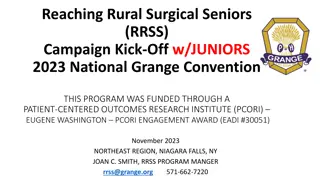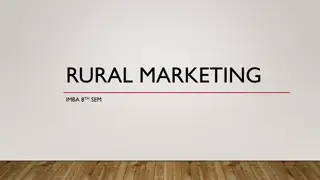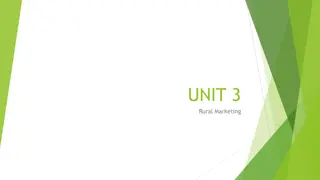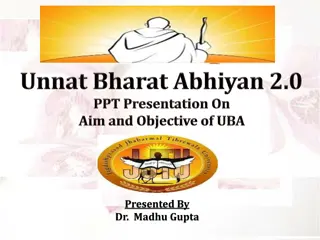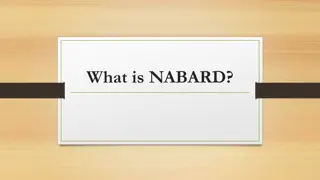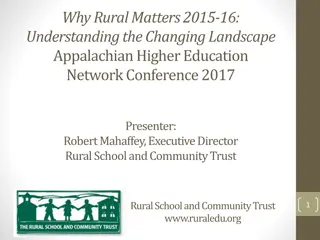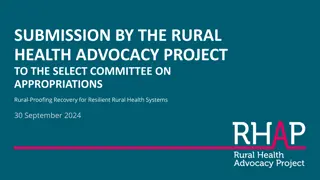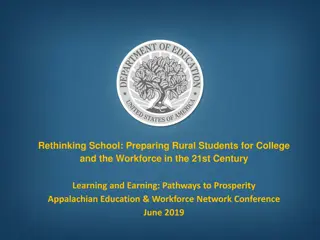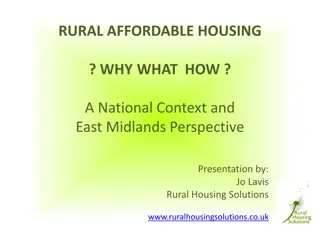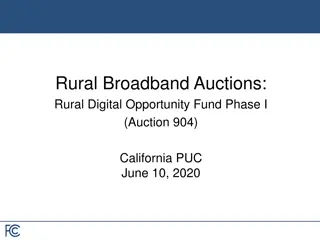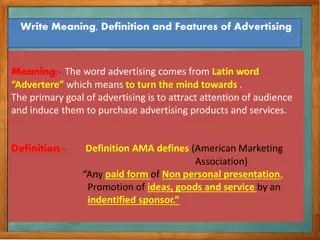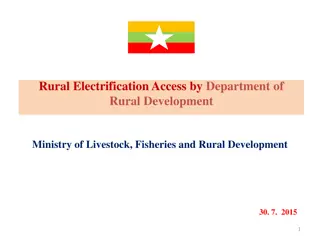Rural Education Achievement Programs: SRSA and RLIS Introduction
The Rural Education Achievement Programs, including the Small, Rural School Achievement Program (SRSA) and the Rural and Low-Income School Program (RLIS), aim to meet the unique needs of rural school districts by providing grants for those lacking resources to compete for federal grants, and for districts receiving small grant amounts. Eligibility criteria and definitions of locale codes are outlined for both programs, and applications are to be submitted following specific guidelines. The programs address challenges faced by rural schools in accessing adequate resources for educational development.
Uploaded on Sep 15, 2024 | 0 Views
Download Presentation

Please find below an Image/Link to download the presentation.
The content on the website is provided AS IS for your information and personal use only. It may not be sold, licensed, or shared on other websites without obtaining consent from the author. Download presentation by click this link. If you encounter any issues during the download, it is possible that the publisher has removed the file from their server.
E N D
Presentation Transcript
Title V, Part B - REAP An introduction to the Rural Education Achievement Programs (SRSA and RLIS)
Purpose To address the unique needs of rural school districts that frequently - 1) Lack the personnel and resources needed to compete effectively for Federal competitive grants; and 2) Receive formula grant allocations in amounts too small to be effective in meeting their intended purposes [ESEA 5202] 9/15/2024 www.michigan.gov/mde 2
Subparts Subpart 1 Small, Rural School Achievement Program (SRSA) Apply and receive directly through USED Subpart 2 Rural and Low-Income School Program (RLIS) Apply and receive through Michigan Department of Education as part of the Consolidated Grant Application 9/15/2024 www.michigan.gov/mde 3
Local Award Eligibility - SRSA A local educational agency (LEA) shall be eligible to receive a grant under this subpart if - i. The total number of students in average daily attendance at all schools served by the LEA is fewer than 600; or ii. Each county in which a school served by the LEA is located has a total population density of fewer than 10 persons per square mile; and iii. All of the schools served by the agency are designated with a locale code of 41, 42, or 43, as determined by the Secretary of Education [ESEA 5511(b)(1)] 9/15/2024 www.michigan.gov/mde 4
Local Award Eligibility - RLIS A local educational agency (LEA) shall be eligible to receive a grant under this subpart if - i. 20 percent or more of the children ages 5 through 17 years served by the LEA are from families with incomes below the poverty line*; and ii. All of the schools served by the agency are designated with a locale code of 32, 33, 41, 42, or 43, as determined by the Secretary of Education [ESEA 5521(b)(1)(A)] *Poverty data is from the Small Area Income and Poverty Estimates (SAIPE) Program 9/15/2024 www.michigan.gov/mde 5
Eligible Locale Code Definitions 32 Town, Distant: Territory inside an urban cluster that is more than 10 miles and less than or equal to 35 miles from an urbanized area. 33 Town, Remote: Territory inside an urban cluster that is more than 35 miles from an urbanized area. 41 Rural, Fringe: Census-defined rural territory that is less than or equal to 5 miles from an urbanized area, as well as rural territory that is less than or equal to 2.5 miles from an urban cluster. 42 Rural, Distant: Census-defined rural territory that is more than 5 miles but less than or equal to 25 miles from an urbanized area, as well as rural territory that is more than 2.5 miles but less than or equal to 10 miles from an urban cluster. 43 Rural, Remote: Census-defined rural territory that is more than 25 miles from an urbanized area and is also more than 10 miles from an urban cluster Urbanized Area = 50,000 or more people Urban Cluster = at least 2,500 and less than 50,000 people 9/15/2024 www.michigan.gov/mde 6
Uses of Funds - SRSA To carry out activities authorized under any of the following provisions: 1) Title I, Part A 2) Title II, Part A 3) Title III 4) Title IV, Part A or B [ESEA 5212(a)] 9/15/2024 www.michigan.gov/mde 7
Alternative Use of Funds - SRSA SRSA-eligible LEAs are also permitted to use Title II, Part A and Title IV, Part A funds to pay for activities under any of the allowable uses for SRSA grant funds. The alternative use authority does not require a transfer of funds to expand the allowable use. LEAs exercising allowable fund use authority (AFUA) must still meet equitable service requirements for the fund. If an LEA uses AFUA for Title IV, Part A they are relived from meeting spending requirements for the various focus areas. [ESEA 5211] 9/15/2024 www.michigan.gov/mde 8
Uses of Funds - RLIS Grant funds awarded to LEAs under this subpart shall be used for any of the following: 1) Activities authorized under Title I, Part A 2) Activities authorized under Title II, Part A 3) Activities authorized under Title III 4) Activities authorized under Title IV, Part A 5) Parental involvement activities [ESEA 5222(a)] 9/15/2024 www.michigan.gov/mde 9
Supplement, Not Supplant Grant funds shall be used to supplement, and not supplant, any Federal, State, or local education funds. Unallowable costs include: 1) Providing services required under state or local law. 2) Providing services that were provided in a prior school year with state or local funds. 3) Providing the same service using federal funds that is provided to other students using nonfederal funds. [ESEA 5232] 9/15/2024 www.michigan.gov/mde 10
Summary - SRSA SRSA funding is targeted to small rural districts. SRSA-eligible districts are given significant flexibility in their use of other federal funds to meet the needs of their students. Funding is intended to enhance or add to existing supplemental programming already in place as part of other federal programs. Student beneficiaries of the funding are dependent on which program(s) the LEAs use the funds to support. 9/15/2024 www.michigan.gov/mde 11
Summary - RLIS RLIS funding is targeted to rural districts with a significant percentage of their student population coming from low-income households. Funding is primarily intended to enhance or add to existing supplemental programming already in place as part of other federal programs. Student beneficiaries of the funding are dependent on which program(s) the LEAs use the funds to support. 9/15/2024 www.michigan.gov/mde 12
















